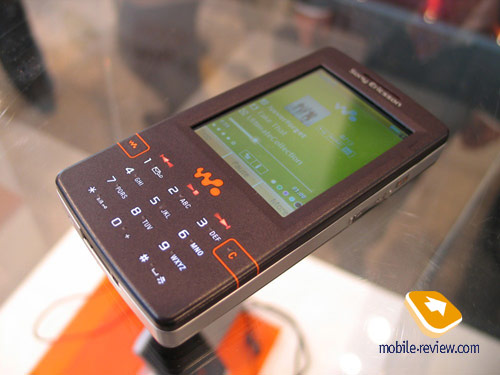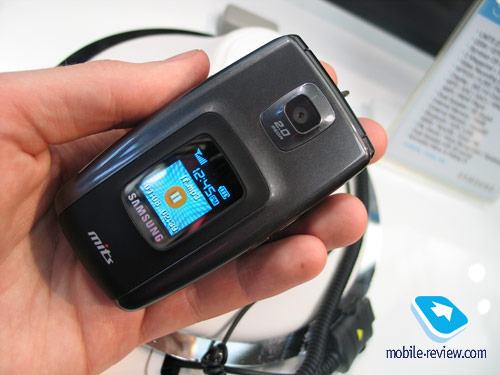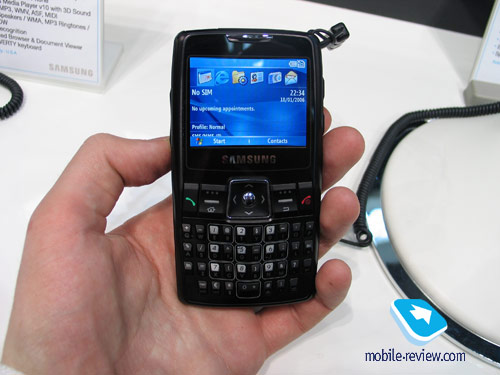|
|
Print this review
3GSM Congress 2006. Symbian, Linux, Windows Mobile
Main event of the exhibition for communicators and smartphones market was Palm's announcement of new operating system based on Linux core. Another surprise was large amount of new models based on Windows Mobile and Symbian.
We knew about most of new communicators before their official announcement at the congress due to numbers of leaks, but Palm's new OS became something truly new, especially since it was announced during Day 2, when most people left hope for something new after Day 1.
ACCESS Linux Platform – big fuzz out of nothing
A year ago, in February 2005, when PalmSource was an independent company, they finished overtaking China Mobile Soft (CMS), it was supposed that CMS with its experience will be managing transfer of Palm OS to Linux Core. In May company showed its progress in developing Palm and Linux combination. In Summer Palm brand was sold completely to palmOne and it became clear that future OS will not contain the term Palm in its title. It was announced that the new OS will not be released earlier than in the 2 nd half of 2006 (that's why we were surprised by this announcement). After long negotiations Japanese company ACCESS acquired PalmSource. It seemed that Japanese decided to force faster development of Palm's new OS, that's why we were able to see its announcement during 3GSM 2006, earlier than planned.
The title of the new OS is obvious and laconically – ACCESS Linux Platform (ALP). Let us remind you that the company does not own rights for Palm brand, this means that this word was not used in the title. What do we have in the end ? Different company, different title, different interface (more information below). Everything that is left from the old Palm OS – ability to launch software written for it. Calling new OS Palm OS's successor is a really illogical thing to do, with the same amount of success you can call Windows Mobile with installed StypeTap emulator successor of Palm OS. The new OS from Access is OS based on Linux Core, with its own UI and Palm OS emulator.
The company is aiming to become the center of mobile version of Linux's ecosystem, they are hoping that ALP will become the dominant among mobile variations of Linux, even though there are lots of them (each manufacturer starts from the core, then develops his own UI and developing kits). During the presentation the company made a allusion to Motorola by saying “one company spent around 200 million USD to develop Linux-Java platform”. On the whole the company's idea is correct, that the moment there are fragmented versions of Linux for mobile devices, there's no one single standard, this slows down Linux's expansion over mobile market, development of third party software.
Besides the will to make the system a giant standard, ACCESS is pointing out advantages of its OS for smartphones (in the presentation main competitors were called by names – Microsoft and Symbian):
- More open-based platform due to Linux;
- The platform is more flexible;
- The competitors system requirements are overstated;
- More customization for operators needs;
- Controlled innovation by the competitors;
- Fast time before the actual release on the market.
Most of the advantages mentioned by the company are overrated, imaginary, they are just part of the main advantage which is Linux's flexibility, at the very same time this is ALP's disadvantage. By presenting overwhelming freedom you can easily ruin compatibility right at the start, this is what ACCESS is aiming for (for example, by replacing important library in the core of the system, half of the programs from the 3 rd party developers will not work).
Let's look at which components ALP is built:
- Standard Linux core v2.6.12 and higher. The manufacturer can use its own core version, but he must follow ACCESS's capability requirements. Customization of the core and drivers – separate commercial service from ACCESS.;
- Optimized version of GIMP ToolKit (GTK+, used for GNOME shell development) – added new interface elements, non required libraries were removed;
- STreamer Multimedia Framework – modular multi-stream media-shell;
- QLite – data base, used everywhere in built-in devices, stores data (PIM and others)
The user interface in ALP is called MAX. The developers are pointing out the following highlights: multitasking, easy access to minimized tasks and applications, convenience in using the device with one or two hands, support of two soft-keys, sensor screen, comfortable menu navigation with the help of 5-d joystick. All these claims have to be tested before making the final conclusion.

Now we shall speak about user level of the platform:
- ACCESS NetFront – well-known browser developed by ACCESS, which will receive the ability to view office documents before its actual release;
- Module responsible for phone part and messages, it will be based on old turn outs from PalmSource. Single shell for SMS, MMS, Email and IM;
- IM and multi-media applications, Hot Sync, Palm Desktop will remain from Palm OS.


Besides launching Palm OS-based programs with the help of emulator (see the photo above, that's a familiar software called Memo), you can also launch GTK Linux-applications, but this requires recompilation (see the example below – minesweeper).

There's also ability to launch Java 2ME-applications, specially designed for MAX interface: on the photo below you can see the mp3 player which works in MAX shell (see soft-keys and upper icon panel).

Supposedly developer kits for manufacturers (ALP SDK) will be released by the end of the year, and first devices will appear in 2007. The company should hurry up: the market is not standing still. It may turn out that by the moment of ALP's commercial launch Qtopia will be accepted as single standard, or Motorola will decide to open JUIX for everyone. …
Symbian – lowering down the price, lowering down the development time
A couple of important announcements were made before the start of the congress. First of all, Symbian Limited presented alternative licensing system which will be available starting from July 2006, royalty fee from one device will be lowered from 7.5USD to 2.5USD. The company believes that this will allow Symbian to enter mass market. Second point was that Symbian, Freescale and Nokia announced development of budget 3G-design for S60 platform. This should reduce time before devices based on S60 by two times, and cutting the costs. All three sides take advantage of that, the only loser in this situation is Texas Instruments, who are losing part of their future processor shipments. One of the most interesting events in S60 world is announcement of working version of Skype for this platform.


Only two new devices based on Symbian were introduced - Sony Ericsson W950 (read more about this device in this article) and Samsung's clamshell Z600 based on S60 OS.

As usual the model is lagging behind similar products from Nokia (old OS, old screen's resolution). The model doesn't have anything special, it's a grown-up in terms of sizes D730. The company refuses to promote MMCmicro standard in S60 based smartphones, instead they are using the widely approved microSD format.
Windows Mobile – more devices
Alike initiative by Nokia/Symbian/Freescale, Microsoft together with Texas Instruments announced promotion of its budget platform for smartphones. It is possible that we will see plenty of low-end smartphones by the end of this year. Maximal attention at the presentations and during announcements was drawn to push-mail technology from Microsoft. International operators Vodafone and T-mobile announced there will to start providing push-mail services in the near future.


HP presented its new communicator HP iPaq hw6900. It is missing one slot, but has WiFi to brag with instead, as well as new OS version and slightly modified keyboard. The rest is the very same and known model iPaq hw6515. We knew almost everything about this product long before its announcement, but the company was waiting for the start of 3GSM Congress to announce this model.



Another expected announcement - communicator Fujitsu Siemens T800. It is similar to HP iPaq hw6900 in specifications and outlook, but it is more massive, because of different GPS chipset.

Wistron SP310 was found “accidentally” at Global Locate booth, it is similar to HP iPaq hw6900 as well.


Samsung was demonstrating reference design of communicator named Kingfish III. The company is not going to produce this model itself, instead they will be acting as OEM-supplier (this model will be released for other brands, with different design).

Motorola confirmed its intentions to release UMTS-edition of Motorola Q.

Samsung presented its clone of Moto Q - model Samsung i320 (more information in this article).

Tatung came to smartphone market with model named M1. We have it in our testing LAB right now, soon you will be able to read the review of this device.

I-mate presented I-mate Smartflip based on HTC Star Track (we expect this device to hit the table of our testing laboratory in a week).


HTC demonstrated its model HTC Trilogy with digital TV Tuner. The phone looks kind of cranky, probably because old model HTC Tornado was added with new features in a real hurry, that's why the design and the outlook were the ones who got hurt.
The last new thing for today is clamshell from ASUS – P305, but it kind of doesn't belong here since it was announced before 3GSM Congress.
P.S. The last thing that I wanted to tell you today, but it is really hard to decide which section this product belongs to – unnamed model from BenQ-Siemens, which was accidentally spotted at Intel booth. We don't know anything about the phone itself, except for the fact that it has digital TV tuner, QVGA screen and it works on Intel processor. Model will most likely not be released .


3GSM Congress. All available articles. Content>>>
Anton Kotov ( anton.kotov@mobile-review.com)
Translated by Alexander "Lexx" Zavoloka (alexander.zavoloka@mobile-review.com)
Published — 23 February 2006
Have something to add?! Write us... eldar@mobile-review.com
|
News:
[ 31-07 16:21 ]Sir Jony Ive: Apple Isn't In It For The Money
[ 31-07 13:34 ]Video: Nokia Designer Interviews
[ 31-07 13:10 ]RIM To Layoff 3,000 More Employees
[ 30-07 20:59 ]Video: iPhone 5 Housing Shown Off
[ 30-07 19:12 ]Android Fortunes Decline In U.S.
[ 25-07 16:18 ]Why Apple Is Suing Samsung?
[ 25-07 15:53 ]A Few Choice Quotes About Apple ... By Samsung
[ 23-07 20:25 ]Russian iOS Hacker Calls It A Day
[ 23-07 17:40 ]Video: It's Still Not Out, But Galaxy Note 10.1 Gets An Ad
[ 19-07 19:10 ]Another Loss For Nokia: $1 Billion Down In Q2
[ 19-07 17:22 ]British Judge Orders Apple To Run Ads Saying Samsung Did Not Copy Them
[ 19-07 16:57 ]iPhone 5 To Feature Nano-SIM Cards
[ 18-07 14:20 ]What The iPad Could Have Looked Like ...
[ 18-07 13:25 ]App Store Hack Is Still Going Strong Despite Apple's Best Efforts
[ 13-07 12:34 ]Infographic: The (Hypothetical) Sale Of RIM
[ 13-07 11:10 ]Video: iPhone Hacker Makes In-App Purchases Free
[ 12-07 19:50 ]iPhone 5 Images Leak Again
[ 12-07 17:51 ]Android Takes 50%+ Of U.S. And Europe
[ 11-07 16:02 ]Apple Involved In 60% Of Patent Suits
[ 11-07 13:14 ]Video: Kindle Fire Gets A Jelly Bean
Subscribe
|























